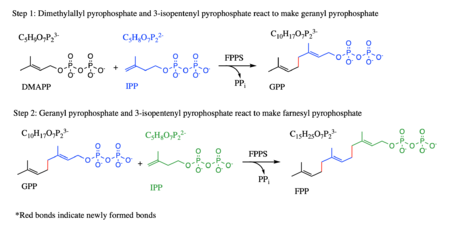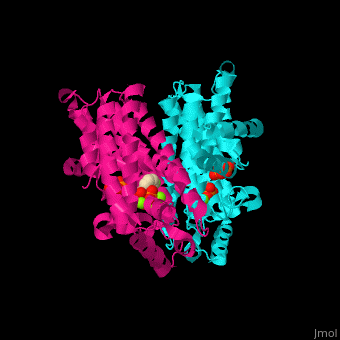Farnesyl pyrophosphate synthase or Farnesyl diphosphate synthase or geranyltranstransferase (FPPS) is a chain elongation enzyme that catalyzes carbon-carbon formation in two consecutive condensation reactions that convert one equivalent of dimethylallyl diphosphate (DMAPP) and two equivalents of isopentyl diphosphates (IPP) into one equivalent of Farnesyl pyrophosphate (FPP). [1]In the first step, IPP and its isomer DMAPP react to form a ten-carbon geranyl diphosphate (GPP), while in the second step, the product geranyl diphosphate from the first step and an additional IPP molecule react to make FPP (see diagram). It is an essential enzyme in the biosynthesis of mevalonate, isoprenoids, and sterols in a variety of organisms. FFPS has been studied in conjunction with different parasites. Bisphosphonates have been shown to inhibit FPPS and are currently being used for osteoporosis and the treatment of various bone diseases. Inhibition of FPPS in parasites such Trypanosoma cruzi (Tc), Trypanosoma brucei (Tb), Toxoplasma gondii and Leishmania major (Lm) displays antiparasitic activity which is being evaluated as putative therapeutics. [2] [3] [4] [5] [6] [7] [8] [9] [10] [11] [12] [13]
Function
In the first condensation reaction, IPP and its isomer DMAPP react to form a ten-carbon geranyl diphosphate (GPP), while in the second condensation reaction, the product geranyl diphosphate from the first step and an additional IPP molecule react to make FPP (see diagram). FPP is an essential enzyme in the biosynthesis of mevalonate, isoprenoids, and sterols in a variety of organisms. FPPS has been studied in conjunction with different parasites. TcFPPS refers to FPPS in the Typanosoma cruzi parasite while LmFPPS refers to FPPS in the Leishmania major parasite. Bisphosphonates have been shown to inhibit FPPS and are currently being used as antiparasitic drugs as well as a treatment for various bone diseases.

Structure
FPPS exists as a homodimer, with each monomer having an active site. The monomers have the characteristic FPPS fold of a ten-helix bundle and four other helices that run perpendicular to the bundle. There are two substrate sites, one is allylic and the other is homoallylic. GPP and DMAPP bind to the allylic site, while IPP binds to the homoallylic site. These two sites are connected to the top of the bundle and exist as part of a cavity[14]. Another characteristic feature of all FPPS enzymes are two highly conserved aspartate rich motifs. These motifs are called , and have sequences of DDXX(XX)D and DDXXD respectively. FARM and SARM are found on opposite sides on the active site cavity facing one another[15].
When FPPS interacts with bisphosphonates, the bisphosphonates bind in the homoallylic binding sites and are coordinated by three divalent cations (Ca2+ or Mg2+). The identity of the bisphosphonate influences which divalent cations bind, as well as whether IPP binds. In the of LmFPPS with 1-(2-hydroxy-2,2-diphosphonoethyl)-3-phenylpyridinium, three Ca 2+ ions and IPP are present.
FPS contains and binds ; see also , (PDB code 2opm)[16], water molecules are shown as red spheres.
Relevance
FPS bisphosphonate inhibitors (like zoledronic acid) are used as drugs for treatment of bone resorption diseases[17]. FPS inhibitor Alendronate or Fosamax is used in treatment of osteoporosis[18]. Bisphosphonates have been explored as antiparasitic drugs with FPPS because current treatments are expensive, have low efficacy, and have dangerous side effects. FPPS is important in the lengthening of hydrophobic chains and determination of their specificity.
Published 3D structures of FPPS
Farnesyl diphosphate synthase 3D structures


